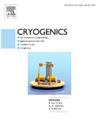Experimental studies on indirect cooling for a hybrid power transfer line (LH2 and HTS)
IF 2.1
3区 工程技术
Q3 PHYSICS, APPLIED
引用次数: 0
Abstract
This contribution presents conceptual designs for a hybrid power transfer line (PTL) with liquid hydrogen (LH2) and high temperature superconductors (HTS). The synergetic combination of chemical and electrical energy transfer provides a high overall efficiency and large power density. To avoid critical material compatibility with hydrogen and improve safety aspects, one option is to place the HTS cable within the same cryostat but separated from the LH2 flow by a protective pipe. A key challenge of this indirect cooling is the heat transfer capability from the cable to the hydrogen. To improve the thermal contact, the protective pipe is filled with helium as a contact gas. Evaluating the indirect cooling needs modelling of heat transfer by natural convection, which relies on empirical correlations. In this work, an experiment is designed to validate the correlations at cryogenic temperatures. The presented test set-up is of reduced geometric complexity and experiments are executed with liquid nitrogen (LN2) at 77 K. The measurement series includes different cable sample topologies and the overall results show a good accordance with a chosen empiric description of natural convection in enclosed space. The outcome enables further quantitative investigations of the indirect cooling concept for hybrid PTLs. Preliminary results predict a sufficient thermal coupling between the HTS cable and stagnant helium.
混合输电线(LH2和HTS)间接冷却实验研究
本文提出了液氢(LH2)和高温超导体(HTS)混合输电线路(PTL)的概念设计。化学和电能传递的协同组合提供了高整体效率和大功率密度。为了避免关键材料与氢气的相容性并提高安全性,一种选择是将HTS电缆放置在相同的低温恒温器中,但通过保护管与LH2流分开。这种间接冷却的一个关键挑战是从电缆到氢气的传热能力。为了改善热接触,在保护管中充入氦气作为接触气体。评估间接冷却需要建立自然对流传热模型,这依赖于经验相关性。在这项工作中,设计了一个实验来验证低温下的相关性。所提出的测试装置降低了几何复杂度,实验在77 K的液氮(LN2)中进行。测量系列包括不同的电缆样本拓扑,总体结果与选定的封闭空间中自然对流的经验描述很好地一致。该结果可以进一步定量研究混合ptl的间接冷却概念。初步结果预测高温超导电缆和停滞氦之间有充分的热耦合。
本文章由计算机程序翻译,如有差异,请以英文原文为准。
求助全文
约1分钟内获得全文
求助全文
来源期刊

Cryogenics
物理-热力学
CiteScore
3.80
自引率
9.50%
发文量
0
审稿时长
2.1 months
期刊介绍:
Cryogenics is the world''s leading journal focusing on all aspects of cryoengineering and cryogenics. Papers published in Cryogenics cover a wide variety of subjects in low temperature engineering and research. Among the areas covered are:
- Applications of superconductivity: magnets, electronics, devices
- Superconductors and their properties
- Properties of materials: metals, alloys, composites, polymers, insulations
- New applications of cryogenic technology to processes, devices, machinery
- Refrigeration and liquefaction technology
- Thermodynamics
- Fluid properties and fluid mechanics
- Heat transfer
- Thermometry and measurement science
- Cryogenics in medicine
- Cryoelectronics
 求助内容:
求助内容: 应助结果提醒方式:
应助结果提醒方式:


